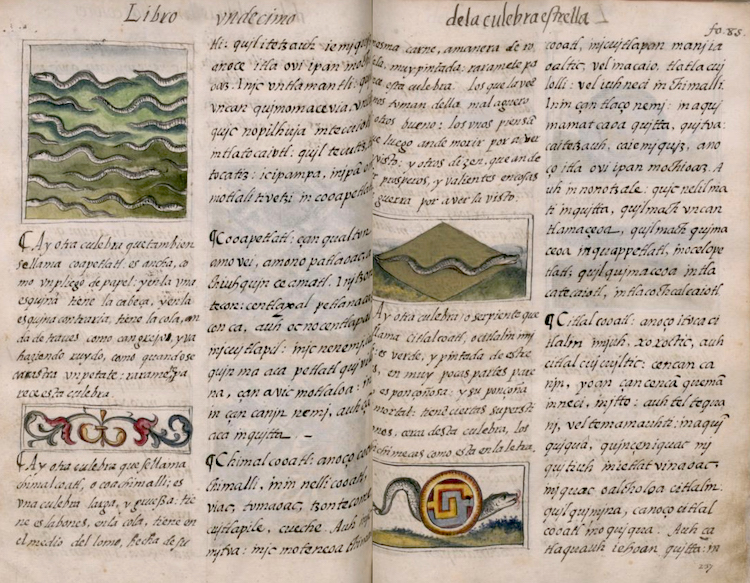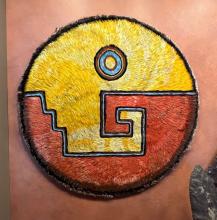Chimalcoatl (FCbk11f85r)
This is a compound glyph represents the chimalcoatl), a type of snake or serpent. The entry concerned with it appears on folios 84 verso and 85 recto in Book 11, “Earthly Things,” of the General History of the Things of New Spain, also known as the Florentine Codex. The compound glyph consists of an image of a snake ([coatl) with a feathered shield (chimalli) superimposed on its mid-section. The snake is undulating to the right with its red, forked tongue projecting from its mouth, and a rattle at the end of its tail. The large shield in its mid-section has a rim of concentric circles of feathers, the outer ones brown, the inner ones yellow fading to white. The center of the shield is blue with a yellow and red stepped fret design (xicalcoliuhqui) of a type often found on war shields. The snake’s body is shaded in grays and has markings replicating its scaly skin. It seems to float above a rolling green landscape.
Robert Haskett
The compound glyph somewhat confusingly appears on the bottom of folio 85 recto opposite the beginning of the text about it in a similar position on the bottom of folio 84 verso, with intervening information about another snake appearing in between. According to the description of the chimalcoatl (which is also sometimes alternatively called a coachimalli, apparently), it is “a long, thick” serpent with a colorful area of scales on the mid-section of its back “like a brightly painted shield.” The text asserts that some of those who see this snake take it as a bad omen “that later they will die,” while others believe that a sighting of the animal is a fortunate thing portending prosperity as well as bravery in war.
Robert Haskett
Chimalcoatl
chimalcoatl
Robert Haskett
1577
Robert Haskett
shields, escudos, rodelas, snakes, serpents, culebras, serpientes, cohuatl, feathers, plumas, ondulante
Photograph by Robert Haskett, Museo Nacional de Antropología e Historia, Mexico City, 14 February 2023.

chimal(li), a shield, a symbol for war, https://nahuatl.wired-humanities.org/content/chimalli
coa(tl), snake, serpent, https://nahuatl.wired-humanities.org/content/coatl
xicalcoliuhqui, stepped fret design, https://nahuatl.wired-humanities.org/content/xicalcoliuhqui
un tipo de serpiente
Stephanie Wood
Library of Congress, https://www.loc.gov/item/2021667856/.
The Library of Congress is unaware of any copyright or other restrictions in the World Digital Library Collection. Absent any such restrictions, these materials are free to use and reuse. Researchers are encouraged to review the source information attached to each item. If you do publish anything from this database, please cite the Visual Lexicon of Aztec Hieroglyphs.



